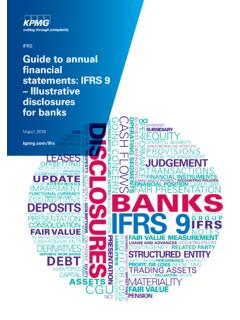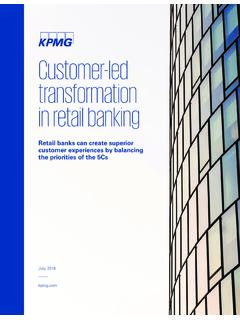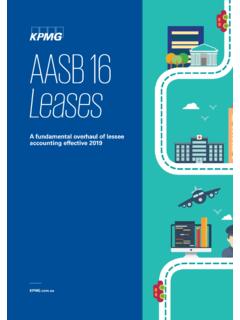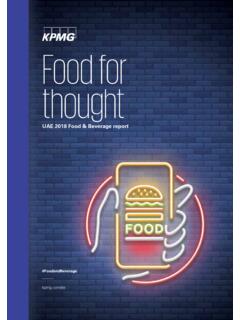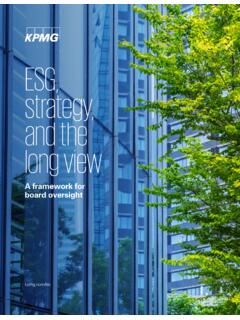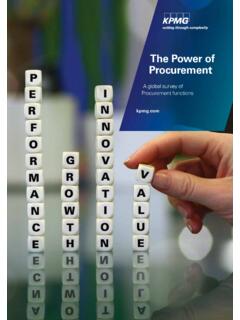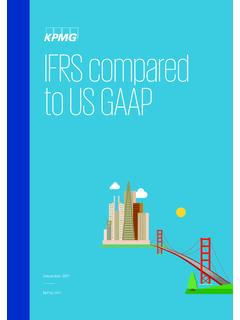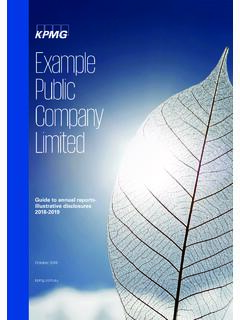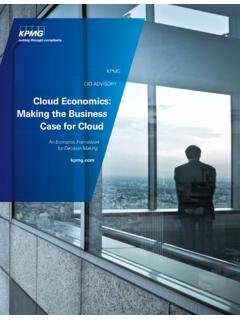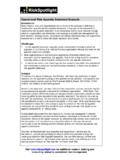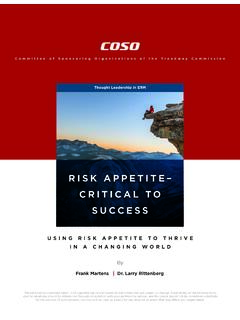Transcription of Developing a strong risk appetite program
1 KPMG INTERNATIONALD eveloping a strong risk < strong >appetitestrong > programChallenges and solutions 2013 KPMG International Cooperative ( KPMG International ). KPMG International provides no client services and is a Swiss entity with which the independent member firms of the KPMG network are issues 3 Technical issues 10 Conclusion 17 2013 KPMG International Cooperative ( KPMG International ). KPMG International provides no client services and is a Swiss entity with which the independent member firms of the KPMG network are Common reference publications include: Financial Stability Board (FSB) s consultative document on Principles for an Effective Risk < strong >appetitestrong > Framework, Basel Pillar 2 ICAAP and Pillar 3 Disclosures, Senior Supervisors Group s 2010 report on developments in risk < strong >appetitestrong > frameworks and IT infrastructure, The Institute of International Finance (IIF) s recommendations and best practices for determining a bank s risk < strong >appetitestrong > , Enhancements to the Basel II framework, Basel Committee on Banking Supervision, July 2009, available at as of August 16, 2013.
2 Creating a robust risk management < strong >programstrong > , and integrating it with broader corporate strategy, is a critical challenge for banks. An explicit and effective risk < strong >appetitestrong > statement is an increasingly important element of this process. The ICAAP process the internal capital adequacy assessment mandated by the Basel Accords has been familiar for some years, and an explicit determination of risk < strong >appetitestrong > is one of the key foundations for this. However, with the aim of improving risk management in the wake of the crisis, regulators in most jurisdictions are placing much greater emphasis on this issue, and supervisory bodies are scrutinizing banks responses much more Common reference publications include.
3 Financial Stability Board s (FSB) consultative document on Principles for an Effective Risk < strong >appetitestrong > Framework, Basel Pillar 2 ICAAP and Pillar 3 Disclosures, Senior Supervisors Group s 2010 report on developments in risk < strong >appetitestrong > frameworks and IT infrastructure, The Institute of International Finance s (IIF) recommendations and best practices for determining a bank s risk < strong >appetitestrong > , etc. In its July 2009 publication titled Enhancements to the Basel II framework, the Basel Committee on Banking Supervision stated it is the responsibility of the board of directors and senior management to define the institution s risk < strong >appetitestrong > and to ensure that the bank s risk management framework includes detailed policies that set specific firm-wide prudential limits on the bank s activities which are consistent with its risk taking < strong >appetitestrong > and capacity.
4 2 Enhancements to the Basel II framework, Basel Committee on Banking Supervision, July 2009, available at as of August 16, 2013. In some jurisdictions, the scope of relevant risk extends beyond financial elements to embrace areas such as brand, reputation, tax planning stance, culture and behavior. In addition, external stakeholders increasingly expect banks to formally document their risk objectives, integrate risk management with wider strategy and clarify the intersection between risk-taking and risk-mitigating this background, boards and bank executive teams need to look afresh at their risk < strong >appetitestrong > < strong >programstrong > to ensure it supports broad bank growth and business strategies.
5 This paper describes several challenges associated with risk < strong >appetitestrong > < strong >programstrong > development, technical constraints associated with implementation and some commonly deployed | < strong >Developingstrong > a strong risk < strong >appetitestrong > < strong >programstrong > 2013 KPMG International Cooperative ( KPMG International ). KPMG International provides no client services and is a Swiss entity with which the independent member firms of the KPMG network are issuesHarmonizing growth, risk and strategic objectivesA key challenge for banks is to bring together, in an integrated and coherent framework, four equally critical but potentially conflicting elements: Overall corporate strategy (the responsibility of the CEO and executive committee) Risk management strategy (CRO) Capital and funding strategy (CFO) The pursuit of operational excellence (COO).
6 Each of these demands has impacts on the others. Resolving the creative tension between them is perhaps the core responsibility of the executive committee to the the strategic plan and the risk < strong >appetitestrong > statementA key issue for the board and executive committee is balancing the natural tension between growth and risk objectives concepts squarely embodied in the strategic plan and the risk < strong >appetitestrong > statement. The strategic plan is a forward-looking document that outlines a bank s mission, guiding principles, values, challenges, and business priorities. It typically covers significant bank initiatives including growth and expansion efforts, large-scale projects, hiring and human capital programs, and community involvement.
7 It describes the bank s philosophy toward risk management and broad measures employed to balance risk and performance. Most companies update the strategic plan every three years. The risk < strong >appetitestrong > statement is a formal articulation of the bank s willingness to accept risk. It is typically linked to the risk management philosophy, and is accompanied by a risk < strong >appetitestrong > framework. The risk < strong >appetitestrong > statement is normally approved by the board annually, and many large banks include the statement in their annual See Basel Pillar 3 disclosure requirements. In 20104 and 2011, large banks and systemically important financial institutions (SIFIs) were encouraged to produce formal risk < strong >appetitestrong > statements to comply with principles defined by the Basel Committee on Banking Supervision (Basel Committee).
8 53 See Basel Pillar 3 disclosure Basel Committee on Banking Supervision, Principles for Enhancing Corporate Governance, October 2010, , available as of August 16. Basel Committee on Banking Supervision, Principles for the Sound Management of Operational Risk, June 2011, available at as of August 16. a strong risk < strong >appetitestrong > < strong >programstrong > | 3 2013 KPMG International Cooperative ( KPMG International ). KPMG International provides no client services and is a Swiss entity with which the independent member firms of the KPMG network are plan principlesRisk < strong >appetitestrong > principles Min. economic capital Min. regulatory capitalSolvencyCapital adequacy Min.
9 Tier 1/capital ratios Min. leverage ratioDisciplined growth (loan volume and revenue) Max. loan-to-deposit ratio Min. earnings growth Min. new loan origination Max. NPA/total assets Max. expected losses Balanced asset mix and qualitySustained profitability Min. ROA and ROE Min. pre-provision net income;Balanced customer qualityrisk-based return Min. RAROC Min. RoRWA Max. Customer, Geography, Product Concentration Max. earnings volatility % Max. NIM volatility %Earnings predictability and stabilityBalanced income sources and balance sheet composition Max. annual earnings, cash or value-at-risk Max.
10 Texas ratio Max. NII/Total incomeEfficient funding structure Max. short-term debt to total debt Min. net stable funding ratio Min. net stable funding ratio Min. liquidity coverage ratio Sufficient liquidityStrategic metric/goalRisk < strong >appetitestrong > metric/goal6 NPA Non Performing AssetRoRWA Return on Risk Weighted AssetsNIM Net Interest MarginNII Net Interest IncomeROA Return on AssetsROE Return on EquityRAROC Risk Adjusted Return on CapitalBoth the strategic plan and risk < strong >appetitestrong > statement are guided by a set of strategic and risk principles. Where feasible, banks assign metrics or thresholds to each principle to operationalize the intended behavior and to evaluate performance againsstated goals.
